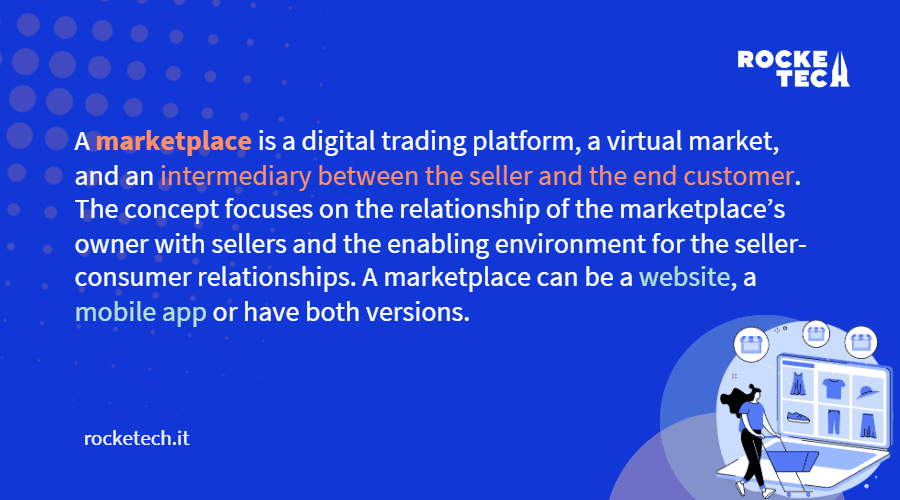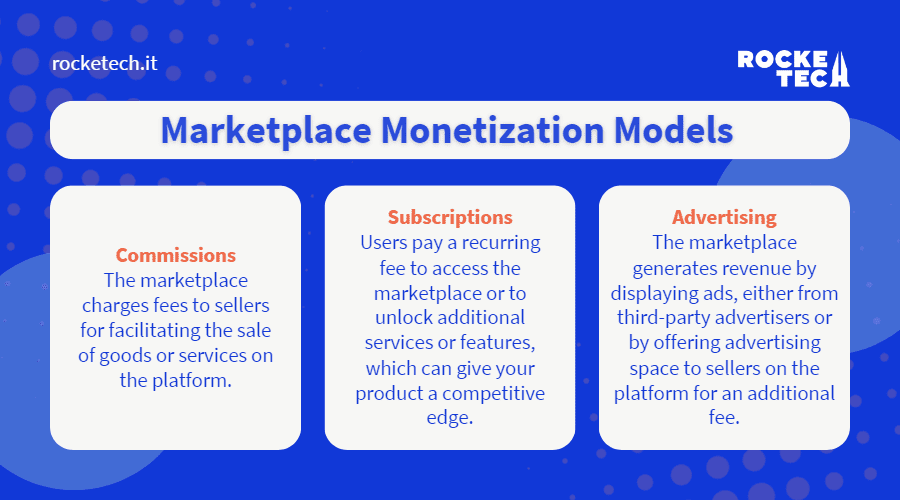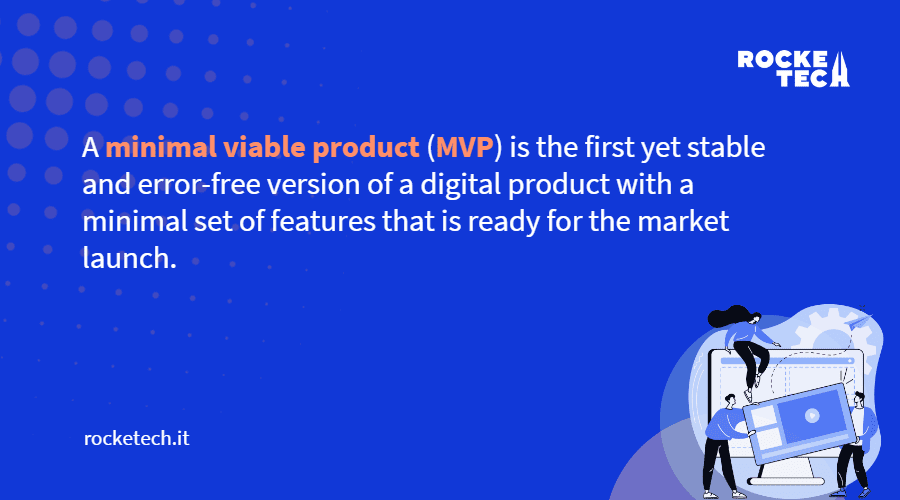In 2023, the total retail e-commerce sales amounted to $5.8 trillion globally. To understand these figures, imagine Australia’s 2022 nominal GDP was $1.6 trillion. Fast-paced digital transformation, the rise of instant e-commerce, and unprecedented events of the global pandemic have accelerated the online marketplace development industry. Today, a “marketplace” no longer exclusively refers to giants like Amazon or AliExpress. Startups successfully launch niche solutions, connecting local vendors to their potential customers.
Although such a project has a lot of factors that impact the outcome, we have summed up the essential guide on how to build a successful marketplace.

Creating a Marketplace: Where Should You Begin?
Selling or exchanging goods or services isn’t an innovation. However, digital evolution and the sharing economy have transformed and adjusted this idea to the ever-changing consumer needs.

The idea isn’t new, and the concept is clear. So why are most marketplaces destined to fail? First and foremost, many founders don’t have a well-defined plan, while the project’s success massively depends on determining the goals and objectives and following the roadmap step by step.
#1 Planning Phase
Some founders neglect the initial planning phase and make the mistake of rushing the launch of a ready product. However, the best way to build a marketplace is to understand what your product will be and who you make it for. This phase covers the following steps.
- Define your product. What will the product be (a website or a mobile app)? What consumer problems will it solve? What is its main idea? What should distinguish it on the market?
- Decide on the type and niche. Will you focus on services or goods? Which niche will you take?
| Marketplace Types | |
| Customer | Business-to-business, business-to-customer, or peer-to-peer |
| Product | Goods, services, coupons, discounts, hybrid, etc. |
| Structure | With vertical structure: offer one product category (e.g., sports goods) With horizontal structure: offer a wide range of products (from baby goods to appliances) |
The type and purpose are not constant. Good projects evolve, which leads to changes in functionality and even the overall product focus. Besides, some narrow markets have a demand for unique, hybrid products. And sometimes the idea works if you look at it from a different angle.
- Define your target audience. Will you target buyers or sellers? Will you work only with individual users or companies? How will enterprise customers know about your application? Which pain points will your product address? How will it be useful for your target audience?
Conduct qualitative research. 1–1 interviews with potential end-users are an endless source of priceless information that will help you avoid many mistakes when deciding on the product’s functionality.
- Analyze your competitors. No matter what you do, someone has already done it before you. Your task is to understand what you can improve in your competitor’s model and offer it to users.
Business insight: Airbnb wasn’t the first accommodation renting startup. But they were among the first to offer real people’s apartments rather than hotels and hostels. On top of that, the company made the offers transparent — they replaced hotel pages with personalized host profiles.
| Looking for more insights from the industry leaders on how to build an e-commerce website? Find them in one extensive guide by DesignRush? |
#2 Choose the Monetization Model
Although it’s part of the planning phase, it should get a special emphasis. The purpose of launching any business is to generate profits. The money you make should be enough not only to cover the platform’s maintenance and promotion but also to bring a net profit. Here are the most widespread marketplace monetization methods.

Commissions
The marketplace can charge commissions for transactions, registration, or listing fees (goods placement like on Etsy). You take commissions from the seller for assisting them in selling the goods.
Subscriptions
Users pay a monthly or yearly fee to use the marketplace or subscribe for additional services or instruments. Extra functionality on top of basic features can grow into your product’s competitive advantage.
Advertising
There are different ways to earn money with ads. With third-party advertising, users usually don’t have to pay for using the marketplace because the ads generate revenue for the service. However, you can also offer main-page ad spaces to the platform’s sellers for an extra fee.
These are only the most common ways to monetize a marketplace. But you need to choose them (often in combination) carefully according to your target audience and their preferences. Also, frequently changing rules negatively impact customer satisfaction levels (in the case you change the pricing model once the product is on the market).
#3 Choose the Approach to Marketplace Development
There are various approaches to the development process. Depending on your long-term objectives and budget, there are three main options.
WordPress and Alternatives
It’s the easiest, fastest, and cheapest option. Using WordPress templates (like Mayosis or DGWork), you can create a website in a few hours, spending from $50 to $1000 (template price + hosting cost). However, this approach lacks customization options and technical support (all technical issues are on you). Besides, you’ll have limited settings.
White Label Solutions
Technically, these are also templates but in the form of ready e-commerce platforms developed by experienced programmers (like Yo!Kart or CS-Cart). Their launch takes longer and costs more because, in addition to development, programmers themselves start, customize and test the site. Technical support is usually also included with White label solutions.
Outsourcing the Development
In general terms, it means delegating the entire process to a group of professionals who create a marketplace app or website from scratch. There are also different approaches to how to choose a development services provider — from finding separate freelancers and managing them yourself to hiring a well-coordinated dedicated team that will take over the entire process, including the product launch and often further scaling. IT outsourcing allows you to create a unique product with quality assurance in a relatively short time.
#4 Create an MVP
Once you have done your market research and decided on the business model of the future online marketplace platform, it’s time to proceed to its direct structure and basic functionality.
Some startup founders tend to create a 100-page preliminary technical specification for the end product. 150+ successful projects completed by Rocketech prove the effectiveness of the agile approach to software development. We break each project down into stages that have smaller objectives. It allows us and our Partners to adjust every new feature and overall functionality to the ever-changing market demand and conditions. Creating an MVP is the first stage of product development in the agile method.
Launching an MVP helps you minimize the risks of building a product that nobody needs. In simple words, you develop and launch a product that already carries value for the end user and see what works well and what doesn’t work at all.
Key Reasons to Create an MVP
At this stage, design and usability are of secondary importance. However, these aspects should be set for the prospect of development and improvement. You’re testing not a specific implementation but an idea.
- The MVP will help you feel the ground and see if the market needs your product.
- A well-functioning MVP is a powerful instrument for attracting investors.
- You can see the problems you will encounter when developing the product’s final version.
- You can gather invaluable feedback from the target audience and learn new ideas for improving the product.
An MVP is necessary if you plan to create a complex application with many features that need continuous testing. It builds the ground for the next crucial step to a successful product.
#5 Hypothesis Testing
Strictly speaking, the MVP enables you to test multiple hypotheses on real users. Every feature you decide to add at further stages should result from such testing. How much will you earn if 100 people start using the app within two months? How much investment do you need to get the required number of users? Will the users pay money for that extra functionality you consider making the primary source of profit?
Furthermore, if the hypothesis is proved, why? Founders often think users need particular functionality, but the solution skyrockets for a different reason.
Business insight: The global e-commerce marketplace Groupon started as an extra feature of a different website, The Point. It was a consumer activism platform offering users to create a campaign for social good and invite others to participate. Another example is the $10B-worth e-commerce ecosystem Shopify which started as an unsuccessful online store selling snowboarding equipment.
The most common misconception is thinking that the only hypothesis to test is whether your product will succeed or fail. In truth, there should be numerous ideas for validation that are concise, easy to understand, and can be tested quickly and accurately.
Product Launch is Only a Milestone
While many founders explore how to build a marketplace app, the more efficient research question is how to create a competitive advantage in the marketplace. It’s no longer about finding something unique but rather understanding your future product, market, and, most importantly, your customers.
At Rocketech, we guide startups throughout the entire process — from the discovery phase to product launch and further scaling. Marketplace development is one of our 12 market expertise domains we handpicked and keep mastering with every project.
Let’s validate and bring it to life together.
